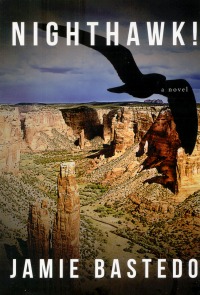| ________________
CM . . .
. Volume XIX Number 19. . . .January 18, 2013
excerpt:
Writing from years of experience working in the field, Jamie Bastedo, biologist extraordinaire, has crafted an exciting and informative novel with a unique point-of-view. The Refugium offers all Nighthawks who nest within its walls the protection and predictability of a life free from predators, hunger, and the extremes of weather. Wisp, a juvenile belonging to the Plebeian class of Nighthawks—those who provide navigation for colony migrations—however, does not see it that way. For him, the winter nesting ground deep in the Ecuadorian Amazon Rainforest is a jungle prison used to monitor and control the population. Desiring independence from the confines of his colony, Wisp sets off for the Arctic Tundra in search of all the adventure and excitement that comes from daring to fly farther than any other Nighthawk has gone before. In what was to be a solo flight, Wisp is frustrated to learn that his sister, Willo, has followed him in the hopes of returning him to his senses and back to the safety of the Refugium. Wisp’s escape has also attracted the attention of Flare, the zealous Guardian Nighthawk bent on capturing Wisp by any means necessary. The journey north is further complicated by the fact that Wisp is in a sense flying blind, having never learned how to read the stars as is required of all Plebeians, a secret he has kept (and continues to keep in his travels) for fear of being revealed as a fraud and humiliated. En route to the Tundra, Wisp encounters numerous characters, and, while most are simply passersby, a few become permanent members of Wisp’s flock. Readers are left to speculate about the truthfulness of these new additions and their overall commitment to reaching the Tundra. This uncertainty is played out, back and forth, throughout the entire novel, working well to build suspense as well as to give certain characters an added measure of complexity and depth. As one would expect, the places visited by Wisp play a principal part in moving the story forward. Each locale, from the Amazon to the Arctic, offers a unique setting from which an interesting set of challenges is introduced. With varying degrees of success, Wisp confronts these obstacles with a headstrong mentality typical of most juveniles. He is quick to realize, especially by book’s end, that most problems are better faced alongside friends and family, and that everything cannot be solved by simply flying away. A strong environmental message is also woven within the story. Subtle at first, revealing itself in the challenges and hardships encountered by Wisp and his friends—slash-and-burn forest clear cutting in Columbia, birds living from the refuse provided by landfills, the encroachment of cities into animal habitat—this narrative builds in spectacular fashion with an exposé of the Alberta Tar Sands. Taken as a whole, these depictions of nature under attack are presented with a genuine intent to inform (and perhaps also alarm) readers of the current ecological state of the planet, and, in particular, that which is happening in the backyard of their own country. Timely, refreshingly honest, and funny, Nighthawk! is an engaging adventure tale which will have a broad appeal. A suitable selection for use in the classroom and at home, Nighthawk! will fit nicely in the hands of young birders (especially) and naturalists of any age, although readers will need to be accepting of having a bird as narrator. Readers interested in similarly themed novels should explore other works by Bastedo, including: Sila’s Revenge, On Thin Ice, and Tracking Triple Seven. Highly Recommended. Andrew Laudicina, an MLIS graduate from the University of Western Ontario in London, ON, he currently resides in Windsor, ON.
To comment
on this title or this review, send mail to cm@umanitoba.ca.
Copyright © the Manitoba Library Association. Reproduction for personal
use is permitted only if this copyright notice is maintained. Any
other reproduction is prohibited without permission.
NEXT REVIEW |
TABLE OF CONTENTS FOR THIS ISSUE
- January 18, 2013.
AUTHORS |
TITLES |
MEDIA REVIEWS |
PROFILES |
BACK ISSUES |
SEARCH |
CMARCHIVE |
HOME |
